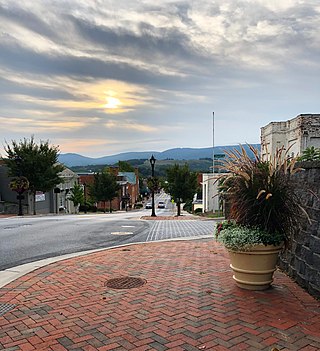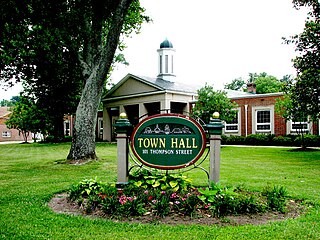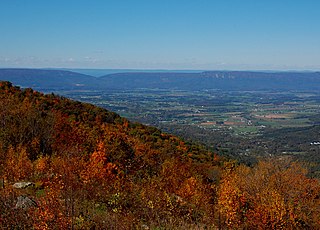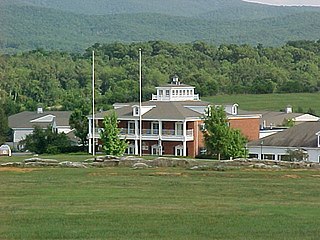
Waynesboro is an independent city in the Commonwealth of Virginia. It is a principal city of the Staunton-Waynesboro Metropolitan Statistical Area. Waynesboro is located in the Shenandoah Valley and is surrounded by Augusta County. As of the 2020 census, the population was 22,196.

Greenville is a census-designated place (CDP) in Augusta County, Virginia, United States. The population was 832 at the 2010 census. It is part of the Staunton–Waynesboro Micropolitan Statistical Area.

Ashland is a town in Hanover County, Virginia, United States, located 16 miles (26 km) north of Richmond along Interstate 95 and U.S. Route 1. As of the 2020 census it had a population of 7,565, up from 7,225 at the 2010 census.

Shenandoah is a town in Page County, Virginia, United States. The population was 2,373 at the 2010 census.

Stanley is a town in Page County, Virginia, United States. The population was 1,689 at the 2010 census.

Grottoes is an incorporated town in Augusta and Rockingham counties in the U.S. state of Virginia. The population was 2,668 at the 2010 census.

The Episcopal Diocese of Washington is a diocese of the Episcopal Church covering Washington, D.C., and nearby counties of Maryland in the United States. With a membership of over 38,000, the diocese is led by the Bishop of Washington, Mariann Budde. It is home to Washington National Cathedral, which is the seat of both the diocesan bishop and the Presiding Bishop of the Episcopal Church.

U.S. Route 340 is a spur route of US 40, and runs from Greenville, Virginia, to Frederick, Maryland. In Virginia, it runs north–south, parallel and east of US 11, from US 11 north of Greenville via Waynesboro, Grottoes, Elkton, Luray, Front Royal, and Berryville to the West Virginia state line. A short separate piece crosses northern Loudoun County on its way from West Virginia to Maryland.
The Battle of Waynesboro was fought on March 2, 1865, at Waynesboro in Augusta County, Virginia, during the American Civil War. It was the final battle for Confederate Lt. Gen. Jubal Early, whose force was destroyed.
Blue Ridge Community College is a community college located in Weyers Cave, Virginia in Augusta County. The campus is located between Interstate 81 and U.S. Route 11 just outside Weyers Cave. The school is a part of the Virginia Community College System and serves students from the cities of Harrisonburg, Staunton, and Waynesboro, Virginia, and the counties of Augusta, Highland and Rockingham. Blue Ridge also has a satellite location at Augusta Health in Fishersville, Virginia.

The Western Maryland Scenic Railroad (WMSR) is a heritage railroad based in Cumberland, Maryland, that operates passenger excursion trains and occasional freight trains using both steam and diesel locomotives over ex-Western Maryland Railway (WM) tracks between Cumberland and Frostburg. The railroad offers coach and first class service, murder mystery excursions, and special seasonal trips.

The Waynesboro Outlet Village, later rebranded Waynesboro Village, was an outdoor outlet mall in Waynesboro, Virginia, as one of Waynesboro's first attempts to make the town a shopping destination. In its heyday, the facility housed factory outlet stores and in later years housed a combination of outlet stores and offices for nonprofit organizations.

The South River is one of the two main tributaries of the South Fork of the Shenandoah River. It begins south of Waynesboro, Virginia, and flows northward to Port Republic, where it merges with the North River to form the South Fork. The river is 52.6 miles (84.7 km) long.
Augusta Health, formerly Augusta Medical Center, is a hospital in Fishersville, Virginia. It serves Augusta County, Virginia, as well as the cities of Staunton and Waynesboro. It is located near I-64. Augusta Medical Center was formed in 1994 as a consolidation of Kings Daughters Hospital in Staunton, and Waynesboro Community Hospital in Waynesboro. Augusta Medical Center changed its name to Augusta Health in June 2009.The campus went tobacco-free in 2009. Augusta Health has a member only gym. It provides cardio, weight lifting, inside and outside tennis courts, basketball, track, pool, and spa for its members. Many classes are offered including wellness and fitness programs. In March 2013 it opened a new $32 million cardiovascular center which is a 67,000-square-foot facility offering nuclear stress-testing machines and two heart catheterization labs. The hospital completed an expansion of its emergency department in November 2019, with major donations of around $2.13 million.

Staunton Mall was a shopping mall in Augusta County, Virginia, United States. It was slightly outside the city limits of Staunton, Virginia. Opened in 1968 as Staunton Plaza, it originally featured J. C. Penney, Montgomery Ward, Woolworth, and Safeway as its major stores. An expansion plan between 1985 and 1987 enclosed the formerly open-air property while adding Leggett as a third department store and renaming the property to Staunton Mall. The mall underwent a number of anchor store changes throughout the late 1980s and early 1990s: Safeway became an outlet store for Sears, then Goody's and Gold's Gym, while Woolworth was converted to Stone & Thomas and then to Peebles, and Montgomery Ward became Steve & Barry's. The mall lost many inline stores throughout the 21st century, and passed through several owners before closing on January 1, 2021.
Belmont Glass Company, also known as the Belmont Glass Works, was one of Ohio's early glassmaking companies. It was named after Belmont County, Ohio, where the plant was located. The firm began operations in 1866 in a riverfront village along the east side of the county, which is known as Bellaire. At that time, the community had resource advantages that made it an attractive site for glassmaking. Bellaire's location at the intersection of the Ohio River, the National Road, and two railroads meant it had an excellent transportation infrastructure. Fuel necessary for the glassmaking process was also readily available, since Belmont County was part of the eastern Ohio coal region. Bellaire also had a workforce with glassmaking expertise located less than five miles away, since glass had been produced in Wheeling, West Virginia, since the 1820s.
Cohasset is an unincorporated community in Fluvanna County, in the U.S. state of Virginia located about two miles west of Fork Union on State Route 6.
Duncan, Colorado was a post office in Saguache County, Colorado about 8 miles south of Crestone, Colorado.
General Electric Specialty Control Plant is a 115 acres (47 ha) historic factory complex located in Waynesboro, Virginia. The complex includes three contributing buildings, one contributing site, and two contributing structures. The historic buildings and structures are a 340,000-square-foot main plant building, the original water tower, water tank, a group of evolved and interconnected construction sheds built from 1953 to the present, and an airplane hangar. The property, a former airport, was acquired by General Electric in 1953. The Waynesboro plant was one of some 120 individual operating departments created as part of a decentralization effort by the General Electric Corporation. The Specialty Control Plant was responsible for the development of breakthrough technologies in areas ranging from America's military efforts to space travel to computer technology. The facility was sold to GENICOM on October 21, 1983.













